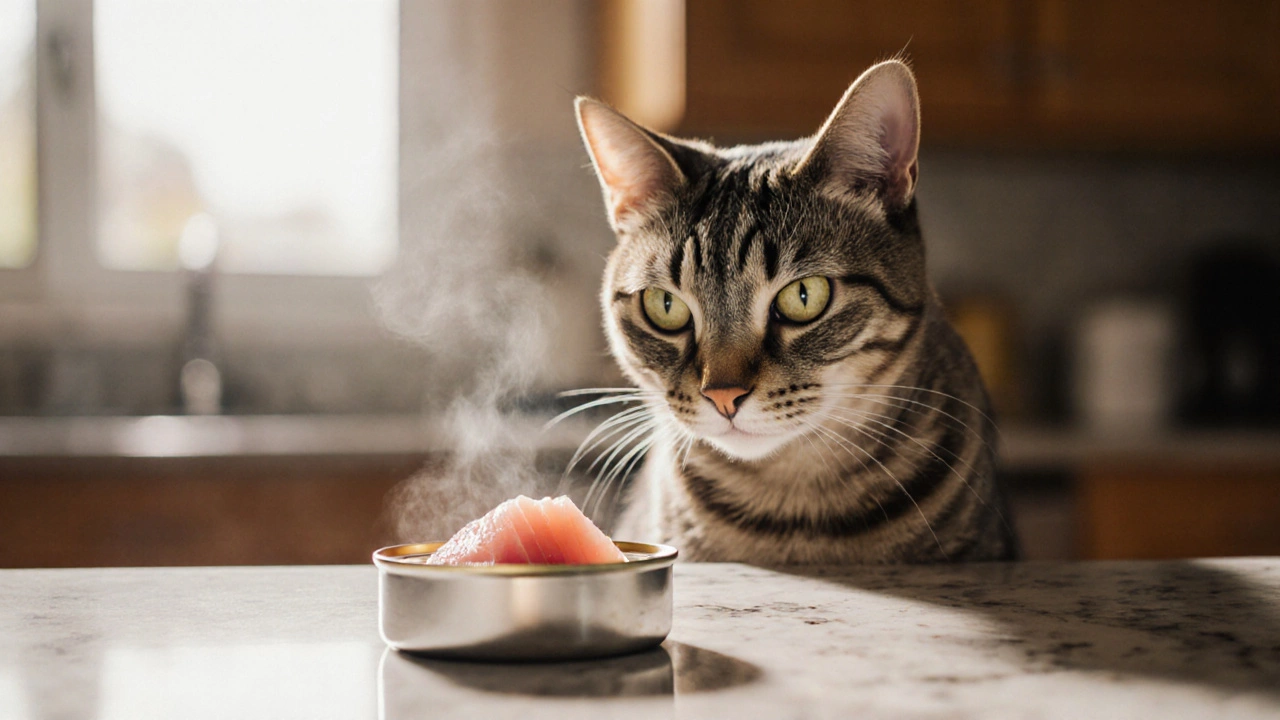Tuna Portion Calculator for Cats
Safe Tuna Guidelines
Recommended weekly portion:
Daily maximum:
Warning: Exceeding these portions may lead to mercury accumulation, thiamine deficiency, or nutrient imbalances. Always mix with complete cat food.
Quick Safety Checklist
When you stare at your feline friend eyeing that tuna can, you instantly wonder: tuna for cats - is it a treat or a trap? Tuna is a salt‑water fish prized for its soft texture and strong aroma, while Cat is an obligate carnivore that thrives on animal protein. Below we break down the science, the safety concerns, and the practical steps to make tuna a healthy occasional snack rather than a daily staple.
Why cats are drawn to tuna
Felines have a keen sense of smell and a natural preference for fishy, oily foods. Tuna packs a potent combination of protein, fat, and the umami flavor that triggers a cat’s hunting instincts. In addition, the strong scent works as a natural appetite stimulant, which can be useful when a cat is a picky eater or recovering from illness.
Nutritional benefits of tuna for cats
When offered in moderation, tuna provides several nutrients that complement a cat’s regular diet:
- High‑quality protein: Tuna contains all essential amino acids cats need for muscle maintenance and growth.
- Omega‑3 fatty acids (EPA and DHA): These help reduce inflammation, support vision, and improve coat shine.
- Vitamin B12: Essential for nervous system health and red blood cell formation.
- Selenium: An antioxidant that assists thyroid function.
These nutrients are especially valuable for senior cats or those with skin allergies, where omega‑3s can ease itchiness and joint stiffness.
Potential health risks of feeding tuna
Despite its perks, tuna isn’t a complete meal for cats. Relying on it too often can lead to serious problems:
- Mercury accumulation: Large predatory fish can contain trace amounts of mercury, which may affect kidney and nervous system health over time.
- Thiamine (vitamin B1) deficiency: Fresh tuna contains an enzyme that destroys thiamine. A diet high in raw or undercooked tuna can cause irreversible neurological damage.
- Excessive sodium: Canned tuna packed in brine or oil often has added salt, raising the risk of hypertension and urinary issues.
- Imbalanced nutrition: Tuna lacks calcium, taurine, and other nutrients that commercial cat foods provide. Long‑term feeding can cause skeletal problems and heart disease.
How to serve tuna safely
Follow these rules to keep the experience positive and risk‑free:
- Choose tuna packed in water, not oil or brine. Rinse briefly to reduce sodium.
- Avoid raw tuna unless it has been frozen at -20 °C (-4 °F) for at least 7 days to kill parasites.
- Limit serving size to about one tablespoon (≈5 g) for an average adult cat, roughly the size of a pea.
- Never use tuna as a meal replacement. Mix it with a balanced wet or dry cat food to ensure a full nutrient profile.
- Observe your cat for signs of upset stomach, vomiting, or lethargy after the first few servings. If any appear, stop feeding tuna and consult a veterinarian.
Feeding schedule and portion guidelines
Because tuna is a treat, treat it sparingly:
| Cat Weight | Weekly Tuna Limit | Notes |
|---|---|---|
| Up to 3 kg (6.6 lb) | 1-2 teaspoons total | Spread across 2-3 days. |
| 3-5 kg (6.6-11 lb) | 2-3 teaspoons total | Mix with regular food each time. |
| Over 5 kg (11 lb) | Up to 4 teaspoons total | Monitor for weight gain. |
These numbers keep mercury intake well below the safe threshold established by the World Health Organization for felines.
Alternatives to tuna that still excite the palate
If you want variety without the risks, consider these cat‑friendly options:
- Cooked salmon: Rich in omega‑3s, low in mercury, and easy to flake.
- White‑bait fish (e.g., cod or pollock): Mild flavor, low fat, and usually free of thiaminase.
- Commercial fish‑based wet foods: Formulated with balanced nutrients, often fortified with taurine and calcium.
- Cat‑safe meat treats: Small pieces of boiled chicken or turkey provide protein without the fish‑related concerns.
Quick checklist before you open the tuna can
- Is the tuna packed in water, not oil or brine?
- Has it been rinsed to reduce salt?
- Is the portion size ≤ 5 g per serving?
- Will it be mixed with a nutritionally complete cat food?
- Do you have a plan to rotate other protein sources?
When to consult a veterinarian
If your cat shows any of the following after eating tuna, call your vet promptly:
- Persistent vomiting or diarrhea
- Lethargy or loss of coordination (possible thiamine deficiency)
- Excessive thirst or frequent urination (signs of kidney stress)
- Unexplained weight loss or gain
Veterinarians in Auckland often recommend a blood test to screen for mercury levels if a cat has a habit of eating large amounts of fish.
Bottom line
Tuna can be a tasty, nutrient‑rich treat for cats when used correctly. Think of it as a garnish, not a main course. By sticking to water‑packed tuna, limiting portions, and monitoring for any adverse reactions, you’ll keep your cat happy and healthy without the hidden dangers.

Can I feed my cat tuna every day?
No. Daily tuna can lead to mercury buildup, thiamine deficiency, and nutrient imbalances. Keep it to a few teaspoons per week and always mix it with a complete cat food.
Is canned tuna safe for kittens?
Kittens have higher nutrient needs and are more vulnerable to thiamine loss. Offer only a tiny amount (about ½ teaspoon) once a week and ensure the rest of their diet is kitten‑specific.
Should I choose tuna in oil or water?
Water‑packed tuna is the better choice. Oil adds unnecessary calories, and brine adds sodium. Rinse the fish briefly before serving.
What are the signs of thiamine deficiency?
Look for loss of appetite, weakness, unsteady gait, and seizures. If you suspect a deficiency, stop feeding tuna and see a vet right away.
Can fresh tuna be given raw?
Raw fresh tuna can contain parasites and thiamine‑destroying enzymes. If you must feed raw, freeze it at -20 °C for a week first, then serve only a tiny portion.





